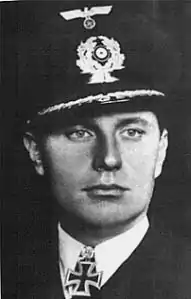Klaus Scholtz | |
|---|---|
 | |
| Born | 22 March 1908 Magdeburg |
| Died | 1 May 1987 (aged 79) Bad Schwartau |
| Service/ | |
| Years of service | 1927–45 1953–66 |
| Rank | Kapitän zur See |
| Unit | SSS Niobe cruiser Berlin Schleswig-Holstein |
| Commands held | Jaguar U-108 12th U-boat Flotilla |
| Battles/wars | World War II |
| Awards | Knight's Cross of the Iron Cross with Oak Leaves |
Klaus Scholtz (22 March 1908 – 1 May 1987) was a commander in the Kriegsmarine (navy) of Nazi Germany during World War II. He commanded the Type IXB U-boat U-108. Scholtz was a recipient of the Knight's Cross of the Iron Cross with Oak Leaves.
Career
Scholtz joined the Reichsmarine in 1927 as member of "Crew 1927" (the incoming class of 1927) and served in torpedo boats, before transferring to the U-boat arm (U-bootwaffe) in April 1940. From October 1940 he commanded U-108, sinking 25 ships on 8 patrols, for a total of 128,190 tons of Allied shipping, including the British armed merchant cruiser Rajputana. In October 1942 Scholtz formed and took command of 12th U-boat Flotilla based at Bordeaux, France.
In August 1944 the approach of Allied troops meant that the base had to be evacuated. The last U-boats escaped by sea, and Scholtz attempted to lead the remaining men (about 220) back to Germany on foot. They left Bordeaux on 26 August, but were captured on 11 September by American forces in Loire. Scholtz spent the next 18 months in US captivity.
Post-war, Scholtz served in the Bundesgrenzschutz-See - the naval arm of the Federal Border Guards - from 1953 to 1956, then transferred to the Bundesmarine, serving as commander of several naval bases, including Kiel, Cuxhaven, and Wilhelmshaven. He retired in 1966 with the rank of Kapitän zur See, and died in 1987.[1]
Awards
- Iron Cross (1939) 2nd and 1st Class
- Knight's Cross of the Iron Cross with Oak Leaves
- Knight's Cross on 26 December 1941 as Kapitänleutnant and commander of U-108[2]
- 123rd Oak Leaves on 10 September 1942 as Korvettenkapitän and commander of U-108[3]
References
Citations
- ↑ Helgason, Guðmundur. "Fregattenkapitän Klaus Scholtz". German U-boats of WWII - uboat.net. Retrieved 18 April 2010.
- ↑ Fellgiebel 2000, p. 387.
- ↑ Fellgiebel 2000, p. 61.
Bibliography
- Busch, Rainer; Röll, Hans-Joachim (2003). Der U-Boot-Krieg 1939–1945 — Die Ritterkreuzträger der U-Boot-Waffe von September 1939 bis Mai 1945 [The U-Boat War 1939–1945 — The Knight's Cross Bearers of the U-Boat Force from September 1939 to May 1945] (in German). Hamburg, Berlin, Bonn Germany: Verlag E.S. Mittler & Sohn. ISBN 978-3-8132-0515-2.
- Fellgiebel, Walther-Peer (2000) [1986]. Die Träger des Ritterkreuzes des Eisernen Kreuzes 1939–1945 — Die Inhaber der höchsten Auszeichnung des Zweiten Weltkrieges aller Wehrmachtteile [The Bearers of the Knight's Cross of the Iron Cross 1939–1945 — The Owners of the Highest Award of the Second World War of all Wehrmacht Branches] (in German). Friedberg, Germany: Podzun-Pallas. ISBN 978-3-7909-0284-6.
- Scherzer, Veit (2007). Die Ritterkreuzträger 1939–1945 Die Inhaber des Ritterkreuzes des Eisernen Kreuzes 1939 von Heer, Luftwaffe, Kriegsmarine, Waffen-SS, Volkssturm sowie mit Deutschland verbündeter Streitkräfte nach den Unterlagen des Bundesarchives [The Knight's Cross Bearers 1939–1945 The Holders of the Knight's Cross of the Iron Cross 1939 by Army, Air Force, Navy, Waffen-SS, Volkssturm and Allied Forces with Germany According to the Documents of the Federal Archives] (in German). Jena, Germany: Scherzers Militaer-Verlag. ISBN 978-3-938845-17-2.
- Thomas, Franz (1998). Die Eichenlaubträger 1939–1945 Band 2: L–Z [The Oak Leaves Bearers 1939–1945 Volume 2: L–Z] (in German). Osnabrück, Germany: Biblio-Verlag. ISBN 978-3-7648-2300-9.